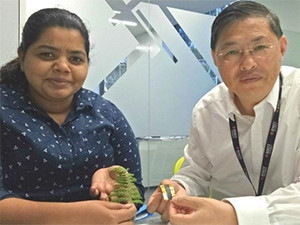
A research team at RMIT University in Australia has developed an electrode that it says could be the answer to the chunky storage still holding back solar as a total energy solution.
Solar-powered batteries on phones have not hit mainstream because they either require a bulky set-up or cannot store enough power for feature-rich flagship devices, for long periods of time and when there is no light.
The new type of electrode could boost the capacity of existing storage technologies by 3 000%.
Published in Scientific Reports, the research details how the new electrode paired with supercapacitors (which are used to charge and discharge faster than conventional batteries) could bring self-powering smartphones, laptops, cars and buildings to fruition.
The researchers say the graphene-based prototype also opens a new path to the development of flexible thin film all-in-one solar capture and storage.
Lead author, PhD researcher Litty Thekkekara, says because the prototype is based on flexible thin film technology, its potential applications are countless.
"The most exciting possibility is using this electrode with a solar cell, to provide a total on-chip energy harvesting and storage solution," says Thekkekara.
"We can do that now with existing solar cells but these are bulky and rigid. The real future lies in integrating the prototype with flexible thin film solar - technology that is still in its infancy. Flexible thin film solar could be used almost anywhere you can imagine, from building windows to car panels, smartphones to smartwatches.
"We would no longer need batteries to charge our phones or charging stations for our hybrid cars."
Natural inspiration
RMIT professor Min Gu says the design was inspired by the American fern and its intricate self-repeating patterns, called 'fractals'. The fractals allowed the researchers to fill a space in the most efficient way possible.
"The leaves of the western swordfern are densely crammed with veins, making them extremely efficient for storing energy and transporting water around the plant," says Gu.
Gu is the leader of the laboratory of artificial intelligence nanophotonics, and associate deputy vice-chancellor for research innovation and entrepreneurship at RMIT.
"Our electrode is based on these fractal shapes - which are self-replicating, like the mini structures within snowflakes - and we've used this naturally-efficient design to improve solar energy storage at a nano level.
"The immediate application is combining this electrode with supercapacitors, as our experiments have shown our prototype can radically increase their storage capacity - 30 times more than current capacity limits.
"Capacity-boosted supercapacitors would offer both long-term reliability and quick-burst energy release ? for when someone wants to use solar energy on a cloudy day, for example ? making them ideal alternatives for solar power storage."
Share